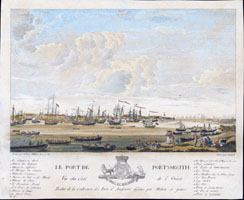Thomas Graves, 1st Baron Graves

Admiral Thomas Graves is best known for commanding the British fleet in its defeat at what many historians consider the decisive naval campaign of the War for Independence: the Battle of the Capes on September 5, 1781. His failure to break through the French navy's blockade of the Chesapeake Bay virtually guaranteed the surrender of Cornwallis' army one month later.
Thomas Graves was born in Cornwall on October 23, 1725, the son of a Rear Admiral. Graves followed his father into the navy and by 1743, after serving in the West Indies, was a Lieutenant in the 50-gun Romney in the Mediterranean during the War of the Austrian Succession. He was on board the Monmouth during the famous British victories off Cape Finisterre in 1747 and eight years later was promoted to Captain in command of the 20-gun Sheerness, then serving in the English Channel. Despite an official reprimand in 1757 for failing to capture a French merchant vessel, Graves advanced in rank and to the command of successively larger vessels, such as the 80-gun Cambridge in 1770. At the beginning of the American War for Independence, Graves was again serving in the English Channel but in 1777 was sent as part of a squadron to the West Indies. On March 19, 1779, he was promoted to Rear Admiral and returned to England.
In May 1780, he entered the War for Independence in earnest when he was sent with six ships-of-line to reinforce the navy in North America and serve as second-in-command to Admiral Mariol Arbuthnot. He was with Arbuthnot on March 16, 1781, when they engaged a French fleet off the mouth of the Chesapeake Bay that was attempting to assist the Marquis de Lafayette in disrupting British Major General Benedict Arnold's operations in Virginia. The British fleet arrived first and succeeded in holding off the French to maintain control of the Bay and access to Virginia. Graves assumed temporary command of the British navy in North America in July 1781 when Arbuthnot returned to England because of poor health.
Later in the summer of 1781, Graves received competing intelligence. One report, which proved false, informed him of a major French fleet headed to New England with critical supplies for the Americans. The other reports, which were true enough, revealed that the French fleet under Admiral de Barras in Rhode Island had set sail for an unknown destination and that Admiral de Grasse's squadron had departed the West Indies to head north along the American coast. Less than eight weeks into his command, and recently reinforced from the West Indies by Admiral Sir Samuel Hood, Graves gave chase on August 31 with a fleet of 19 ships-of-the-line. Graves reached the Chesapeake on September 5, 1781, to find de Grasse waiting for him, with 26 French ships-of-the-line barring the entrance to the Bay. Graves went into line of battle and attempted to close with the French but winds and currents carried both fleets out to sea. The action did not commence until late in the afternoon, with both sides inflicting heavy casualties on the other until sunset ended the engagement. For the next several days, the fleets kept each other in sight but, despite Graves' best efforts, were not able to close. Graves lost sight of the French on September 10 and returned to the Bay only to find on September 11 that de Grasse had united with Barras' fleet from Rhode Island, thereby outnumbering the British two-to-one. Graves immediately sailed to New York to reinforce and repair his ailing fleet, not knowing how dire Cornwallis' situation at Yorktown was rapidly becoming.
When Graves reached New York on September 20, the British commander-in-chief, Sir Henry Clinton, was preparing a relief force to go to Cornwallis' aid. On October 19, 7000 men, 25 ships-of-the-line and eight frigates set sail for Virginia. When they reached the Bay on October 27, Graves learned that Cornwallis had surrendered on the day of his departure, so the force changed course and returned to New York. Graves, having already received orders to report for duty in the West Indies, left for Jamaica on November 10. Shortly after arriving in the West Indies, Graves, concerned for his reputation following the debacle at Yorktown, requested and received permission to return to England to defend himself.
After a harrowing voyage during which Graves lost his flagship, the 74-gun Ramillies to a storm, he reached Ireland on October 10, 1782 and then proceeded straight to London. Although the ensuing months and years were exceedingly unpleasant as parliamentary inquiries into the conduct of the war caused an explosion of finger-pointing in political, military, and naval circles, Graves emerged relatively unscathed — at least officially — and continued his naval career. He was promoted to Vice Admiral in 1787 and Admiral in 1794. Graves was heavily engaged in battles once more with the French when war broke out in 1793, distinguishing himself particularly in the Battle of the Glorious First of June on June 1, 1794, during which he was seriously wounded and compelled to retire. For his service, Graves was created Baron Graves. He died at home in Cornwall on February 9, 1802.





